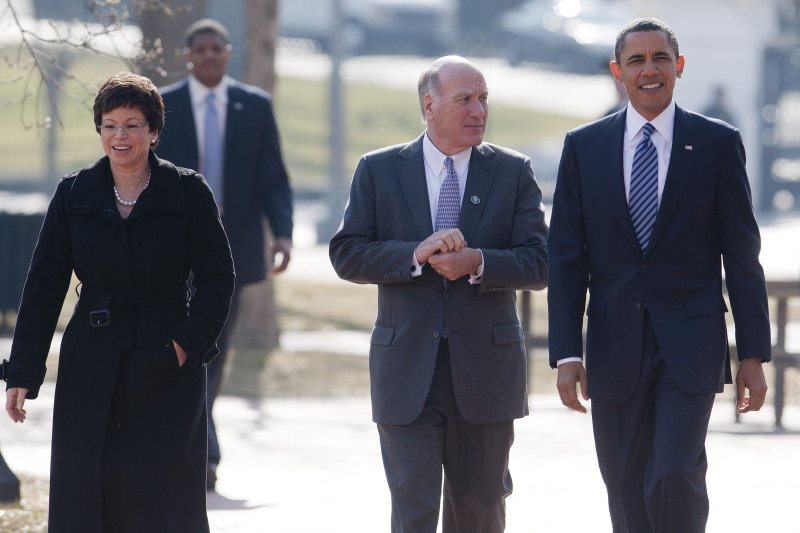U.S. President Barack Obama, right, walks with William Daley, White House chief of staff, and Valerie Jarrett, senior adviser to Obama, to the U.S. Chamber of Commerce in Washington, D.C., on February 7, 2011. UPI/Andrew Harrer/Pool |
License Photo
COLLEGE PARK, Md., Feb. 11 (UPI) -- Friday, the U.S. Commerce Department reported the U.S. economy's deficit on international trade in goods and services was $40.6 billion in December, up from $38.3 billion in November and $27.1 billion in mid 2009, when the economic recovery began.
This rising deficit subtracts from demand for U.S. goods and services, just as stimulus spending and additional temporary tax cuts add to it. The deficit is slowing the recovery and jobs creation, and the Obama administration and Republicans in Congress haven't offered a credible policy to significantly change it.
Jobs creation
The economy added 36,000 jobs in January and that was particularly disappointing after surges in holiday retail sales, business spending and auto sales.
Americans have returned to the malls and new car showrooms but too many dollars consumers spend go abroad to purchase imports but don't return to buy U.S. exports. This leaves too many Americans jobless and wages stagnant and the resulting slow growth leaves state and municipal governments with chronic budget woes.
By January 2014, the private sector must add more than 13 million jobs to bring unemployment down to 6 percent. Current policies aren't creating conditions for 5 percent gross domestic product growth that could be achieved and is necessary for businesses to hire 370,000 workers each month.
Since December 2009, the private sector has added 92,000 jobs per month but most of those have been in government subsidized healthcare and social services and temporary business services. Netting those out, core private sector jobs creation has been a meager 42,000 per month -- that comes to less than 14 permanent, non-government-subsidized jobs per county for more than 5,000 job seekers per county.
During the early stages of an economic expansion, temporary jobs appear first but 19 months into the recovery, permanent, non-government-subsidized jobs creation should accelerate. Instead, core private sector jobs were up only 43,000 in January -- down from 73,000 in the fourth quarter.
Economic growth
Commerce Department preliminary estimates indicate GDP growth was 3.2 percent, significantly disappointing Wall Street economists.
Consumer spending and business technology and auto sales all added strongly to demand and growth and exports actually outpaced imports for the first time in a year. Pessimism, caused by rising gasoline prices, healthcare reform and import competition, caused businesses to run down inventories rather than add new capacity and employees.
Fourth quarter exports got a boost from a weaker dollar against the euro earlier in 2010 -- the export effect of a weaker or stronger dollar occurs with a lag of several months; however, this situation is likely to reverse in the 2011, owing in particular to Europe's continuing sovereign debt woes. November will likely prove to be the low point for the trade deficit, as imports of oil and consumer goods from China overwhelm any further progress in U.S. export growth.
Oil and goods from China account for nearly the entire trade deficit and without a dramatic change in energy and trade policies, the U.S. economy faces large trade deficits and unacceptably high unemployment indefinitely.
The de facto moratorium on new offshore drilling permits in the Gulf of Mexico, imposed by onerous licensing requirements, and policies that limit development of other conventional energy supplies are premised on false assumptions about the immediate potential of electric cars and alternative energy sources, such as solar panels and windmills.
In combination, limits on conventional energy development and excessive optimism about alternative energy technologies are making the United States even more dependent on imported oil and more indebted to China and other overseas creditors to pay for it.
Led by Ford and GM, the automobile industry is demonstrating it can build many more attractive and efficient gasoline-powered vehicles than it is selling now and a national policy to accelerate fleet replacement would spur growth and create jobs much more rapidly than investments in battery and electric technologies.
The trade gap with China did ease to $20.7 billion but remains the largest U.S. deficit with any country. This gap was affected by depletion in U.S. inventories in the fourth quarter and will likely head up again, especially in spring, after the Chinese New Year. The latter celebration often affects the pace of Chinese exports, bunching shipments into March.
To keep Chinese products artificially inexpensive on U.S. store shelves, Beijing undervalues the yuan by 40 percent. It accomplishes this by printing yuan and selling those for dollars other currencies in foreign exchange markets. Annually, those purchases exceed $450 billion or 10 about percent of China's GDP and 35 percent of its exports.
U.S. President Barack Obama has pleaded with China to stop manipulating its currency but Beijing shrewdly recognizes Obama lacks the will to meaningfully counter Chinese mercantilism with strong, effective actions. Hence, Beijing offers token gestures and cultivates political support among U.S. businesses, like Caterpillar, which lead in outsourcing jobs to China and profit from Chinese protectionism at the expense of American workers.
Obama should impose a tax on dollar-yuan conversions in an amount equal to China's currency market intervention divided by its exports -- about 35 percent. That would neutralize China's currency subsidies that steal U.S. factories and jobs. It isn't protectionism; rather, in the face of virulent Chinese currency manipulation and mercantilism, it's self-defense.
--
(Peter Morici is a professor at the Smith School of Business, University of Maryland School, and former chief economist at the U.S. International Trade Commission.)
--
(United Press International's "Outside View" commentaries are written by outside contributors who specialize in a variety of important issues. The views expressed do not necessarily reflect those of United Press International. In the interests of creating an open forum, original submissions are invited.)















